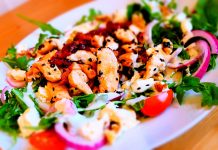
Ironically enough, I found your website by looking up that silly Cabbage Soup Diet. After reading what many doctors and health workers had to say about it, I’ve found that there is no such thing as a “Sacred Heart Memorial Hospital” (the hospital that supposedly prescribes this hideous starvation-torture diet) and furthermore, there never was. There is a Sacred Heart Hospital in Spokane, but it does not endorse this diet at all.
I started reading through your fad diet topic and found some interesting information in there, like that your body is only capable of losing 1/2 pound of real body weight per day (not water) and what starving yourself can do. I never even heard of ketosis before I got on your website! I must say, you do provide a service!
Since I plan to be the meal provider of my household, I’m anxious to learn about proper nutrition. I have to start from somewhere, so could you tell me about the exchange list that you mentioned? I’m hoping to safely and effectively lose 10 to 15 pounds by October so I can fit into this wedding dress.
I understand that you have a high volume of emails, so I tried looking around for this exchange list as much as I could. However, your website is so full of information, that rather than finding that list, I found that I’ve got a lot to learn about feeding a family in a healthy manner.
I’m also sending you just one of the many reviews I’ve discovered about the Cabbage Soup Diet. The only good news, people say, is that it gets you to eat your vegetables! Thank You!
Thanks for your kind comments.
The exchange list was originally used in treating diabetes and was found to be effective for weight control. Now diabetic nutrition therapy utilizes carbohydrate counting to control blood glucose levels where people with diabetes count the number of carbohydrate servings they eat per day since it is the carbohydrate part of food that most influences blood sugar.
The exchange list groups foods with similar calories, protein, fat, and carbohydrate together. Dietitians still use the exchange list to create individualized, healthy eating plans for people who want to lose weight.
You can get your own copy of the carbohydrate counting (exchange lists upgrade) from the Food Lists for Weight Management. The booklet doesn’t have any standardized calorie plans (1,200, 1,500, 1,800) though and you would need to know how many calories you need to achieve your weight goal. You can use the exchange list for weight loss and then to maintain your goal weight. You will learn healthier eating habits that you can follow for the rest of your life. No need for any popular diet to lose weight. If you gain more than 5 pounds due to increasing your portion sizes or decreasing exercise, you can immediately adjust your serving sizes smaller and increase your exercise to get back to your goal weight. It is that simple.
Have you tried my Healthy Body Calculator®? Using your physical data (height, weight, age, gender, physical activities) and your weight goal (lose 1 to 2-pounds per week), it will determine how many calories you should eat to achieve your weight goal. Then on the calculator results page, click the button for “do you need a healthy eating plan”. Your data will be transferred to HELP Healthy Eating For Life Plan®. You can choose your preferences for the type of milk, meat, beans, and snacks. Your personalized eating plan is linked to a small food database from which you can create menus. I would suggest redoing the Healthy Body Calculator® after every 10-pound weight loss as your Calorie Goal will be lower. Then redo HELP to get an updated eating plan. These are the only tools you need to achieve your weight goals.
Hope this helps with your role as meal provider for your family.



